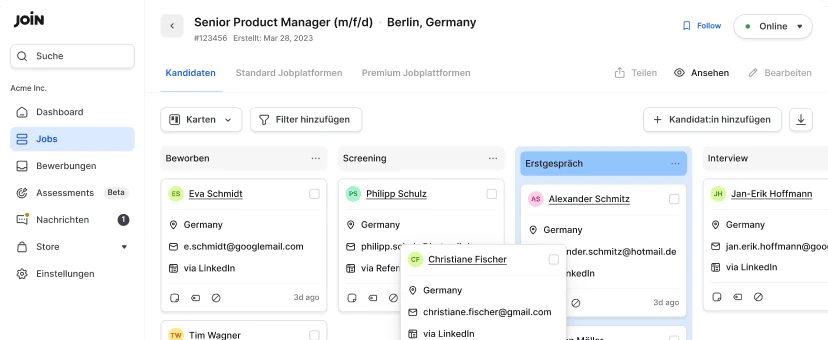7 essential talent acquisition metrics you should track
In the ever-evolving landscape of talent acquisition, staying ahead of the game is crucial for organisations looking to acquire and retain top talent. One of the key strategies to achieve this is by measuring the right talent acquisition metrics to inform your hiring decisions.
Table of contents
These metrics provide valuable insights into the efficiency and effectiveness of your recruitment process, enabling you to make data-driven decisions and optimise your hiring strategy.
In this article, we’ll explore the most important talent acquisition metrics to track in 2024. From time to fill to offer acceptance rate, we’ll cover the metrics that will help you streamline your recruiting efforts and achieve your organisational goals.
What you’ll learn:
- What are talent acquisition metrics?
- Why you should track talent acquisition metrics
- 7 talent acquisition metrics to track your success
- How to further perfect your talent acquisition strategy
What are talent acquisition metrics?
Talent acquisition metrics are specific data points and measures used by recruiters, hiring managers, and talent acquisition professionals to assess the effectiveness, efficiency, and overall success of their talent acquisition process.
These metrics enable organisations to understand their recruitment process in depth and make data-driven decisions to enhance their talent acquisition strategies. As such, by keeping track of essential metrics, companies can more accurately measure success to further grow their business.
Note that these metrics often strongly overlap with the key performance indicators (KPIs) the talent acquisition team tracks. However, metrics can be more general, while KPIs tend to be more specific. As the name implies, they are more important as they are the key performance indicators, while metrics can be any type of data point a company measures.

Why you should track talent acquisition metrics
Tracking talent acquisition metrics is essential for several reasons. Firstly, it allows you to assess the effectiveness of your recruiting process and identify areas for improvement.
Secondly, it enables you to make data-driven decisions, ensuring your hiring strategy aligns with your organisational goals. Lastly, tracking these metrics helps you save time and resources by streamlining your talent acquisition process and reducing recruitment costs.
Now, let’s delve into the top talent acquisition metrics you should be tracking in 2024.
7 essential talent acquisition metrics you should track
If you don’t measure what’s happening, chances are your recruitment team isn’t achieving the best possible results. But by keeping a close eye on the recruiting metrics listed below, you’ll have a better understanding of what’s going on and where you can improve.
Ultimately, this will not just help you find new employees faster and more efficiently, but it’ll ensure you acquire the most suitable candidates for your company.
1. Time to fill
One of the critical metrics to track is the time to fill. This metric measures the length of time it takes to fill vacant positions in your organisation, from the identification of a candidate to their final hiring.
While the ideal time to fill may vary depending on the industry, it is crucial to optimise this metric to ensure a smooth and efficient recruiting process. That’s because a shorter time to fill offers numerous benefits.
Firstly, it improves the productivity of hiring managers who spend less time on the process, allowing them to focus on other essential tasks.
Secondly, it reduces the chances of qualified candidates losing interest due to a lengthy hiring process, ensuring you secure the best talent available. Lastly, faster hiring alleviates the burden on existing team members who are eagerly awaiting the vacancy to be filled.
Note that there’s another common metric, time to hire, that’s similar to this metric yet slightly different. For more information, check out our Glossary article on time to hire.
2. Quality of hire
Another vital talent acquisition metric to track is the quality of hire. This metric measures the contribution a new hire makes to the long-term success of your organisation. It evaluates factors such as their performance, manager satisfaction, career progression, and overall tenure within the company.
Assessing the quality of hire is crucial as it helps you understand the effectiveness of your recruitment efforts. By tracking this metric, you can ensure that you are attracting and retaining top talent, enabling your organisation to achieve its long-term goals faster and improve the overall retention rate.
Additionally, focusing on the quality of hire saves your organisation time and resources in the long run, as you invest in candidates who have the potential to make a significant impact.
3. Cost per hire
Effective cost management is crucial for any organisation and department, and talent acquisition is no exception. Tracking the cost-per-hire metric allows you to assess the various expenses incurred during the recruitment process, such as sourcing costs, travel costs, relocation expenses, and agency fees.
Calculating the cost per hire is simple: add up all the recruitment expenses and divide them by the total number of new hires in a given period. By monitoring this metric, you can identify areas where costs can be optimised, potentially reducing your recruitment expenses.
Note that the cost per hire is closely related to the above-mentioned time-to-fill metric, as a shorter recruitment process often leads to lower costs.
4. Offer acceptance rate
The offer acceptance rate is a crucial talent acquisition metric that measures the number of candidates who accept job offers compared to the total number of offers extended. A low offer acceptance rate indicates that there may be issues with your hiring process or the attractiveness of your offers.
To improve this metric, consider evaluating your job descriptions to ensure they are clear, compelling, and free from any unnecessary information. Additionally, reassess your job flexibility and remote work policies, as these factors can significantly impact a candidate’s decision to accept an offer. Of course, the salary you offer for your positions will impact the number of job offers accepted.
Analysing your competition’s strategies for attracting talent and evaluating your workplace culture are also effective ways to increase your offer acceptance rate.
5. Candidate conversion rate
Speaking of rates, another one of the most important metrics to keep an eye on is the candidate conversion rate. The candidate conversion rate is a percentage of how many potential applicants have submitted an application after viewing your company’s job advertisement.
This could be on your company career page, but it could also be that a job seeker spotted your job ad on one of the job boards where you published it.
Also read: The best job boards for employers in 2024
This conversion rate is calculated by dividing the total number of applications you received for a job opening by the total number of potential candidates who viewed your job opening. If many potential candidates see your job ad, but you barely receive any applications, you know something is wrong.
Next, you can identify bottlenecks that might be the cause of this. From a poorly written job description to an overly complicated application process. By monitoring the candidate conversion rate metric, you can more easily identify such problems in your process that harm your recruitment success.
6. Channel effectiveness
Channel effectiveness is a talent acquisition metric that looks at the different recruitment channels you are using and how effective they are for acquiring new hires.
These channels could include your career page, job sites, social media channels, etc. This metric is closely linked to the previous metric of the candidate conversion rate. Because if your channel is not effective in reaching the right job seekers, your ad might still get a high number of views but few applications.
For example, say you notice the effectiveness and candidate conversion rate is particularly low on a specific job board. Now you know, you can take action and try another job board, for example, a niche job board, instead.
7. Hiring diversity
In today’s diverse and inclusive world, hiring a diverse workforce is not only a legal (and moral) requirement but also a strategic advantage. Tracking the hiring diversity metric allows you to assess your organisation’s efforts in promoting equal opportunity and eliminating discrimination based on race, gender, age, or any other protected characteristic.
Embracing hiring diversity has numerous benefits. Firstly, it reduces turnover rates, as diverse teams tend to have higher employee satisfaction and engagement. Secondly, it fosters innovation and creativity by bringing together individuals with different perspectives and backgrounds.
Lastly, diverse teams are better equipped to solve complex problems, as they can draw from a wider range of experiences and insights.
Suggested read: 13 steps to improve your diversity recruiting strategy!
How to further perfect your talent acquisition strategy
Tracking talent acquisition metrics is essential for organisations looking to optimise their recruitment process and attract top talent. From time to fill to offer acceptance rate, each metric provides valuable insights into different aspects of your recruitment strategy.
By measuring and analysing these metrics, you can make data-driven decisions, streamline your hiring process, and achieve your organisational goals. Remember, talent acquisition is an ongoing process, and regularly monitoring these metrics will help you stay ahead of the competition and build a strong and diverse workforce.
So, start tracking these metrics today and unlock the full potential of your talent acquisition efforts in 2024 and beyond. And for even more useful insights and to keep learning how to reach your talent acquisition goals, check out these other resources:
Frans Lelivelt
Frans is JOIN's multilingual Senior Content Manager. His main topic of interest in the recruitment space is DEI and how companies can reduce their (unconscious) biases to make the world of work a fairer, kinder place for everyone. Outside of work, he tries to do the same for animals, spending much of his spare time in the kitchen preparing plant-based feasts.


